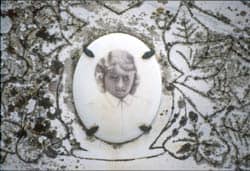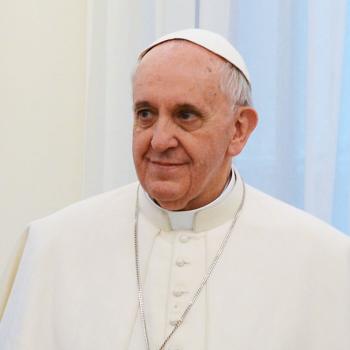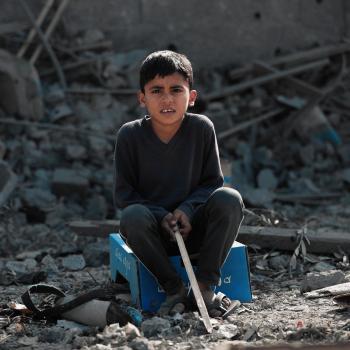Later the camino was a Roman trade route, nicknamed the Milky Way by travelers as it followed the Milky Way to the Atlantic Ocean. In the Middle Ages, it became the Camino de Santiago, or the Way of St. James, and has been in constant use. More than 200,000 people walked at least part of the route last year.
The scenery is spectacular, the towns picturesque, the photo opportunities abundant, and the wine and food are very good. Again, we will have daily critiques, to bring everyone's photographs to the next level, and on our return, we are organizing a gallery show and a book of images from the participants.
I've seen some of your photographs and they display a keen interest in the expression of religious devotion. Can you talk about that for a bit? Why so many devotional images? What is the draw?
I'm not sure. When I first started photographing them in Tuscany, I was with a couple of photographers who, like me, had had a workshop with Joel Meyerowitz, who felt the only real photos were photojournalistic. So while they were trying to snatch photos of the old men, old ladies and children, I was in the churches hunting out icons, frescos, candelabra, saints' statues with symbols of their martyrdom, old bones and relics. I was very unsure I was doing the right thing, and my companions were pretty sure I wasn't. But I loved the colors, the drama, the weirdness; all that drew me. And perhaps I was responding to the energy that anything that has been the object of devotion over the centuries must possess. And at the end of the trip, when we showed each other what we had shot, I think they were surprised and impressed.
Another thing: I went to a psychic years ago, and she said I had a past life in Greece—a very nice life, she said—and I made small devotional objects for people, which were highly prized by them. So maybe that is also driving me.
I'm also fascinated by spontaneous highway memorials to crash victims. Just about anything to do with dead people, I'm there. Cemeteries are pretty cool too, particularly Italian ones, where they put a photo of the dead person on the gravestone. Those photos are so poignant.
How do you go about selecting your subjects?
First you have to trust your gut. There's a physical excitement when you see something you want to photograph. Your eyes widen and you think, "oooooh, that is so cool."
Second, having trusted your gut, you probably have a cluster of photos on a theme, and you want to make sure the theme is filled out. If you keep going to the same spot, for example, you might want to visit it in all seasons, all weather.
And sometimes, it's just pure luck: perhaps a gift from Fortuna.
How important is your photography to your own spiritual expression?
I'm in the business of making images that move the viewer. I have an image I call the Golden Road—it's been a good seller for me over the years—and at a show a woman came up to me. She told me she had bought a small photo of the Golden Road the previous year and had put it on her desk at work. "It gives me hope that there is something better out there ahead of me." That's a lot for a 4x6 photo!
I would say it's my way of paying homage. The magical aspect of photography is that it stops time. That fleeting moment is gone forever, forever caught. Because of that there is, I think, a sweet melancholic aspect to a photo. I love looking at old photos in an antique store - even other people's families draw me in, make me wonder about their lives. Photography pulls me through time - both forward and backwards - and for me there is something sacred about that. It's a way of remembering my dead.
 Do you have any upcoming projects?
Do you have any upcoming projects?
I'm starting work on a book of my sacred images, which will be expanded during our photo tour to Italy in September. Another book I'm working on contains images evoking the ancient Greek deities. A photography book of my experience on the Camino de Santiago is available now on blurb.com, and the trip to the Basque country in April next year will certainly call for an expansion of that portfolio.
I offer photo tours of the Hudson Valley, where I live. Visitors to the area are often eager to get great photos but are at a loss as to the best places to go at the best times. And many of the famous views are known to local artists but are not on any map.
I am also one of the owners of RiverWinds Gallery in Beacon, NY, and I have an etsy store (maryannglassphotos), where I sell photos and some of my jewelry. My website contains my ongoing portfolio. I also maintain a blog and, last but not least, I am a wedding and event photographer, and that portfolio is on http://www.feteaccompli-photo.com.
What advice would you give to someone who wanted to become a photographer?
Start shooting. If you can, take your camera with you wherever you go and shoot what interests you. And take lots of shots of it, varying your angles, distance, etc. Don't be afraid to experiment, to do crazy things. And take classes and workshops. Not only do you learn a great deal from the instructor, but also from the group. And check out my blog, where I discuss what makes for an effective image.
Mary Ann, thank you so much for speaking with me today. Good luck on your Basque country and Tuscan tours. I know I for one am certainly looking forward to your upcoming books!





